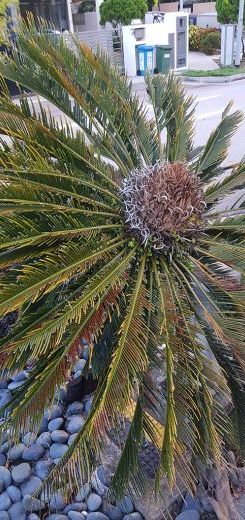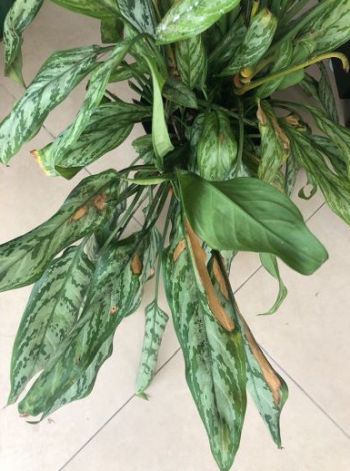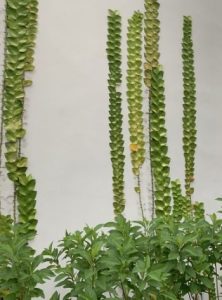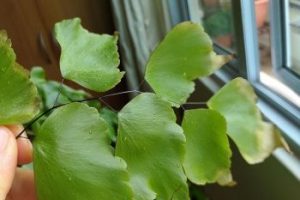Gardening FAQ #13 – What You Need To Know
In this article, we talk about how to handle caterpillar attack, what shingle plant need, conditions for chinese evergreen and much more. Let’s go through the common gardening FAQ, problems and solutions you need when growing your plants either indoor and outdoor.
Cycad may have been weakened by caterpillar attack
 I have a palm tree which has stopped growing new leaves. I previously used a pesticide when there were new leaves growing, but they would still die. There seems to be another plant growing on the palm tree and the trunk seems to have a fungus. Is the tree still alive? What should I do?
I have a palm tree which has stopped growing new leaves. I previously used a pesticide when there were new leaves growing, but they would still die. There seems to be another plant growing on the palm tree and the trunk seems to have a fungus. Is the tree still alive? What should I do?
The plant is not a true palm and is commonly mistaken for one due to its common name. It is a species of cycad that is botanically known as Cycas revoluta.
Your plant may still be alive as it has green leaves. Consider giving the plant some water-soluble fertiliser that also has trace elements to boost its health and promote growth.
Clear out the pebbles at the base of the plant and apply a layer of chipped dry leaf mulch to help retain moisture and promote root zone microbial growth.
The young leaves of this cycad are often attacked by caterpillars of the cycad blue butterfly.
If the infestation is not eradicated in a timely manner, the plant can be weakened over time because no new leaves – which are needed for photosynthesis – are produced.
A recommended practice is to spray a pesticide to protect new leaves whenever they are produced. You can use pesticides such as Spinosad and abamectin, which are very effective in controlling caterpillars.
These pesticides are absorbed into the leaf tissues after they have been applied, so they will not be washed away by the rain.
If you want to get rid of pest caterpillars in your garden once and for all, try the tip in the video today.
For suggestions on how to control another plant worst enemy, head over to our section on Weed & Moss Control.
Shadier conditions more suitable for Chinese Evergreen
 My plant, which is grown in soil, is in my balcony. It gets adequate sun, water and fertiliser regularly. Light brown spots have started appearing and, at times, white droppings are seen on the leaves, as if there is decay or disease permeating the plant. What is wrong with the plant and how can I make it healthy again?
My plant, which is grown in soil, is in my balcony. It gets adequate sun, water and fertiliser regularly. Light brown spots have started appearing and, at times, white droppings are seen on the leaves, as if there is decay or disease permeating the plant. What is wrong with the plant and how can I make it healthy again?
The plant is commonly known as the Chinese Evergreen belonging to the genus Aglaonema.
The brown patches appear to be burn marks brought about by excessive exposure to direct sunlight. The patches are like open wounds that allow secondary infections to take place.
Prune the damaged portions.
Note that this plant thrives under shadier conditions. You can grow it in a location with filtered sunlight for four to six hours daily.
It should be kept moist at all times and not be allowed to dry out excessively.
Shingle Plant needs humid spot with filtered light
 What is the name of this creeper plant?
What is the name of this creeper plant?
The plant is botanically known as Rhaphidophora korthalsii. Its common name is Shingle Plant. It is a member of the yam family (Araceae) and grown as an ornamental plant due to its curious growth habit.
Once the plant’s new growth finds a suitable surface, it will start to grow on it and attach to the surface via its roots. Leaves grow closely on the surface.
The yellow leaves may indicate that the plant is being grown under rather dry and sunny conditions. The Shingle Plant does better under a shadier, more humid spot with filtered sunlight.
If you want to grow this indoors under a controlled environment, read our post on Guide to Growing Tents.
Maidenhair fern appears to be drying due to new environment
 I have been nurturing this fern for nearly 10 years in my air-conditioned office. It received filtered light and I watered it every day. As I have to work from home, I took it back and placed it in a balcony where it received filtered light. My home is not air-conditioned. I am aware the plant does not like strong wind, so I move the pot from the balcony to my room if it is windy. It is well-watered and there is no sign of infestation. Of late, many leaves have been browning at the edges. The browned leaves appear fairly evenly throughout the plant, but I sense more are present on branches sheltered from light. I had observed this even when the plant was in my office, but it is more pronounced now. How can I rectify the issue?
I have been nurturing this fern for nearly 10 years in my air-conditioned office. It received filtered light and I watered it every day. As I have to work from home, I took it back and placed it in a balcony where it received filtered light. My home is not air-conditioned. I am aware the plant does not like strong wind, so I move the pot from the balcony to my room if it is windy. It is well-watered and there is no sign of infestation. Of late, many leaves have been browning at the edges. The browned leaves appear fairly evenly throughout the plant, but I sense more are present on branches sheltered from light. I had observed this even when the plant was in my office, but it is more pronounced now. How can I rectify the issue?
The fronds of your maidenhair fern (Adiantum species) appear to be drying out under the warmer conditions at home. Generally, the plant does better in a cooler, shadier location.
The problem could have occurred due to the rather abrupt transition from office to home. Note that the existing leaves on the plant were produced in the earlier, cooler office environment.
If you have other plants at home, you may want to move your maidenhair fern near them, as the plant community’s collective transpiration can create a more humid microclimate that may suit the fern better.
If you want to grow this indoors under a controlled environment, read our post on Guide to Growing Tents.
